هل يمكننا رؤية مثل هذه الاعمال ضمن منهاج مادة تركيب وانشاء المباني في كلياتنا....
سؤال ارجو منه اجابة عملية
Student Works: Singapore University of Technology and Design Library Pavilion

Student Works: Singapore University of Technology and Design Library Pavilion | City Form Design Lab
During the day, it offers a shaded open-air place to relax, work, and mingle for students and staff of the university. At night it becomes a place for informal gatherings, evening lectures and SUTD community events. Work desks, mobile bookshelves and wireless internet transform it into a "third space" between the dormitory and the classroom where intellectual and social exchange occurs in a casual atmosphere

Architects: City Form Lab
Location: Dover Rd, Singapore
Design Team: Andres Sevtsuk, Raul Kalvo
Engineering: Russel Cole, Mike King, Benjamin Sitler
Construction: Arina International Hogan, SUTD Students
Area: 300 sqm
Year: 2013
Photographs: Raul Kalvo, Courtesy of City Form Lab
Location: Dover Rd, Singapore
Design Team: Andres Sevtsuk, Raul Kalvo
Engineering: Russel Cole, Mike King, Benjamin Sitler
Construction: Arina International Hogan, SUTD Students
Area: 300 sqm
Year: 2013
Photographs: Raul Kalvo, Courtesy of City Form Lab

The Singapore University of Technology and Design (SUTD) library pavilion is located on a sloping lawn on the temporary Dover Campus. Accommodating three mature trees and forming a noise barrier toward the Ayer Raja Expressway in the north, the gridshell structure of the pavilion harnesses the site constraints and activates an outdoor space behind the existing library building. During the day it offers a shaded open-air place to relax, work, and mingle for students and staff of the university. At night it becomes a place for informal gatherings, evening lectures and SUTD community events. Work-desks, mobile bookshelves and wireless Internet transform it into a "third space" between the dormitory and the classroom where intellectual and social exchange occurs in a casual atmosphere.

Building upon a long tradition of catenary structures that use little material to achieve considerable spans, the canopy forms a lightweight timber shell with no columns, beams, or vertical walls. A numeric hanging-chain model was used to determine an efficient double-curvature shape that follows the lines of thrust in compression. Using computational design and computer controlled fabrication allowed the pavilion's complex three-dimensional form to be achieved with readily available materials and a streamlined assembly process at minimal cost. Unlike steel gridshells, it has no complex three-dimensional structural joints – all of its elements were prefabricated from strictly flat plywood and galvanized steel sheets on CNC machines in Singapore.
The site work thus comprised an orderly assembly of 3,000 unique plywood and 600 unique sheet-metal tiles based on only one drawing – the numeric map of a three-dimensional puzzle indicating which pieces fit next to which other pieces. ID numbers were engraved in the cutting process on each plywood and cladding element, which remain visible in the finished structure as ornament. First year SUTD students assisted with the pre-assembly of the pieces and the contractor erected the structure on site. The pavilion is designed to be dismantled and recycled after two years.

- © Raul Kalvo
- © Raul Kalvo
- © Raul Kalvo
- © Raul Kalvo
- Courtesy of City Form Lab
- © Raul Kalvo
- © Raul Kalvo
- Courtesy of City Form Lab
- Floor Plan
- Plan Section
- Section
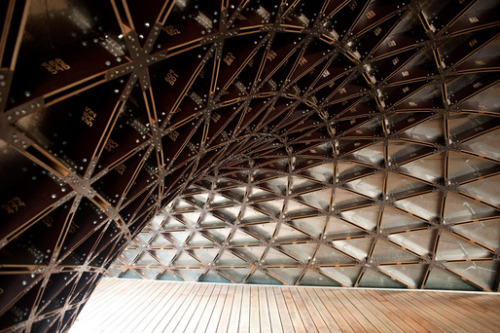
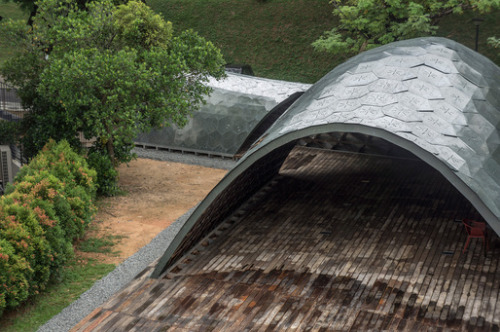
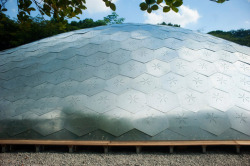
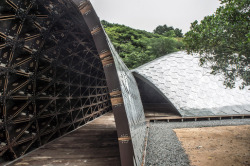
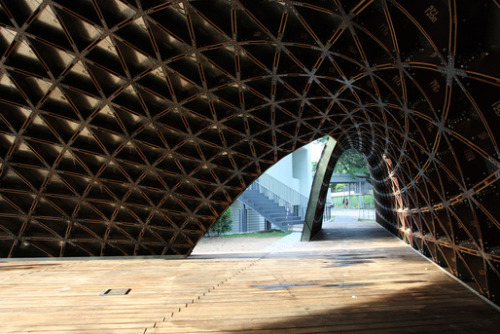
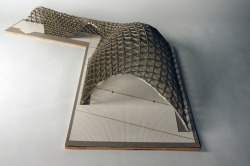
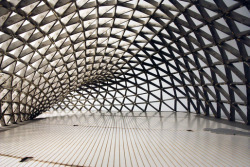


Dr. EMAD HANI ISMAEEL
Ph.D. in Technologies for the Exploitation
of the Cultural Heritage .
Senior Lecturer in the Dept. of Architecture
College of Engineering , University of Mosul
Mosul - Iraq .
E-mail: emadhanee@yahoo.com
Web Site: http://sites.google.com/site/emadhanee/
Tel : +964 (0)770 164 93 74











تعليقات
إرسال تعليق